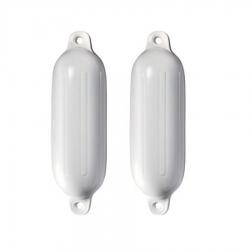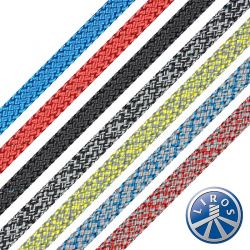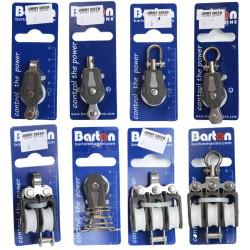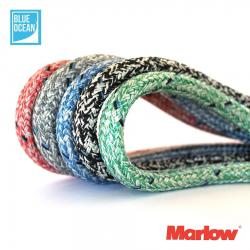Maintenance Guide for cromox® Stainless Steel Anchor Chains
Introduction
cromox® stainless steel anchor chains are engineered for high performance in demanding marine environments. Their strength and durability depend on both the intrinsic qualities of the materials used and on correct handling, installation and maintenance. This guide outlines essential practices to ensure your chain delivers a long and reliable service life.
Pre-Installation Works
Proper preparation before installation is required to maximise corrosion resistance and mechanical integrity from day one.
1. Existing set-up inspection
The primary objective of pre-installation works is to remove existing staining and contaminants from surfaces that come into contact with the chain. These can become embedded on the chain surface and compromise the corrosion resistance of the chain.
- Windlass - Check the gypsy for signs of excessive pocket wear and corrosion. Replace with original manufacturer spares or request a pocket wheel quote from cromox to suit the chain.
- Anchoring Equipment Check: Ensure all associated equipment (shackles, swivels, bow rollers) is stainless steel of similar or higher grade. Mixed-metal contact can cause galvanic corrosion.
- Smooth Transition Points: Check all chain passage points (rollers, guides, gypsy) for sharp edges or tight spots that could damage the chain surface.
- Deck and locker surface - Corrosion stains must be removed from all chain movement and storage surfaces. Stubborn areas will require a new gel or epoxy coating.
- Lubricants and Greases: Only use marine-safe, non-corrosive products if lubrication is required. Avoid any materials containing chlorides or sulphur compounds.
- Electrical Isolation: If the vessel’s electrical system may come into contact with the chain (e.g. bonding wires, grounding systems), ensure proper insulation is in place to prevent electrochemical corrosion.
2. Choose the correct material - environmental Consideration
- Material Suitability: Confirm that the selected chain material (e.g. AISI 316L, AISI 318LN, AISI F225) matches the anticipated water conditions (freshwater, coastal, deep-sea or polluted harbours).
- Temperature and Salinity: When anchoring in warm or high-salinity environments, select materials with high PREN and CPT values (e.g. AISI 318LN or AISI F225).
- PREN (Pitting Resistance Equivalent Number): Should be ≥33 for seawater; cromox® 318LN guarantees ≥35
- CPT (Critical Pitting Temperature): Indicates the onset temperature of pitting corrosion; higher is better
- Fresh Water: Corrosion risk is low but not zero, especially near industrial zones or pools
- Salt Water: Demands high-grade stainless steel. AISI 316L is the minimum, with AISI 318LN or F225 preferred for long-term use
- Extreme Conditions: Only AISI F225 is recommended
- Optional electropolishing is available for improved resistance against contaminants becoming stuck on the surface
3. New Chain Inspection
- Visual Check: Examine each chain link for signs of rust-like discolouration or damage that may have occurred during shipping
- Dimension Verification: Confirm that the chain dimensions (e.g. link thickness, length) match your system’s specifications and are compatible with your windlass, gypsy and connectors
- Cleanliness: Clean the chain with fresh water to remove any contaminants and residues accumulated during storage or transport
- Avoid Surface Contamination: Never install a chain that has come into contact with rusty metals or carbon steel particles. Contaminants can embed into the surface and compromise corrosion resistance
4. Documentation and Traceability
- Retain any quality certificates, test reports or batch documentation provided by the manufacturer. These may be required for warranty claims or future assessments
- It may be beneficial to document the pre-installation works and include photos
Maintenance
To maintain the integrity and appearance of your cromox® anchor chain:
- Rinse the chain with fresh water before and after use
- Avoid contact with saltwater-exposed ropes and rusty metals
- Smooth any burrs immediately
- Prevent long-term submersion in brackish or biologically active water
- Keep the chain surface clean, especially in anchor lockers where moisture and contaminants can accumulate
Cleaning
- Use only non-corrosive, non-abrasive methods
- Avoid high heat or techniques that could conceal surface flaws
Inspection
- Check under good lighting
- Remove the chain from service if you detect:
- Loss of link thickness >10%
- Deformation, elongation or cracking
- Cuts, rust-like discolouration or signs of pitting
What to look out for: Types of Corrosion
- Surface Corrosion: Rare; low material loss threshold
- Intercrystalline Corrosion: cromox® chains are resistant
- Crevice Corrosion: This can occur when moisture and particles are trapped
- Pitting Corrosion: Most common; appears as small rusty holes
Corrosion Influencing Factors
- Sediments, biofilms and organic matter
- Mechanical or thermal surface damage
- Chlorinated cleaners or strong oxidising chemicals
- Contact with non-stainless or galvanically incompatible metals
- Electrical currents from poor grounding or faulty systems
Service and Repairs
Do not attempt self-repairs. Signs of damage or wear should be assessed by Ketten Wälder GmbH or an authorised technician. Improper repairs may void warranties and compromise safety.
Expert Support
For assistance with chain selection, installation advice or site-specific recommendations, contact Ketten Wälder GmbH. Our team is available to help ensure your cromox® chain performs to the highest standards.













